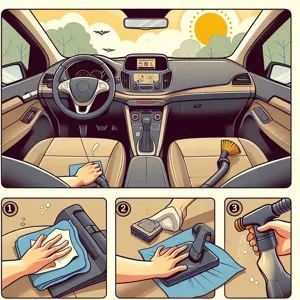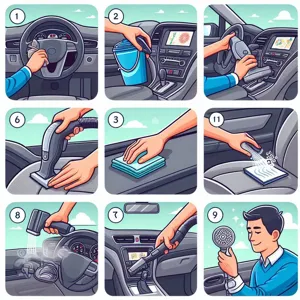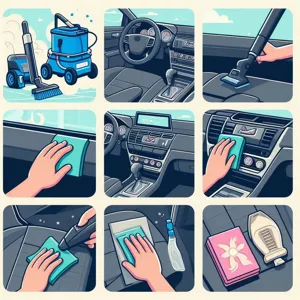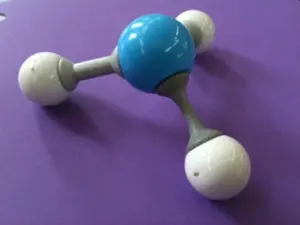For motorcycle enthusiasts, there’s nothing quite like the thrill of hitting the open road on a perfectly polished ride.
However, the joy of ownership comes hand-in-hand with the responsibility of maintenance, and that includes keeping your motorbike clean and well-detailed. A well-maintained bike not only looks stunning but also performs at its best and can last for years to come. In this blog post, we’ll explore pro tips and tricks that will take your cleaning and detailing game to the next level. From the best products to use for different surfaces to the most effective techniques for removing dirt and grime, we’ll cover everything you need to know to revitalize your bike. Whether you’re prepping for a weekend ride or simply want to admire your prized possession in its best light, these expert insights will ensure your motorbike shines and performs flawlessly, ready for any adventure that lies ahead.
1. Introduction: The Importance of Cleaning and Detailing Your Motorbike

When it comes to motorbike maintenance, cleaning and detailing often take a backseat to more mechanical concerns. However, dedicating time to this essential aspect of bike ownership not only enhances its aesthetic appeal but also contributes significantly to its performance and longevity. A clean motorbike isn’t just a sight to behold; it reflects the care and pride that a rider takes in their machine.
Regular cleaning removes grime, dirt, and road salt that can accumulate over time, potentially leading to rust and corrosion. This is particularly crucial for metal components, which require protection from the elements to maintain their structural integrity. Additionally, a thorough detailing process can reveal issues such as leaks or wear and tear that might otherwise go unnoticed, allowing you to address problems before they escalate.
But the benefits extend beyond mere upkeep. A well-maintained motorbike will not only perform better but will also provide a smoother, safer ride. The gleaming finish and spotless chrome can instill a sense of pride as you hit the open road, turning heads and sparking conversations with fellow riders and admirers alike. Moreover, if you ever decide to sell your bike, a pristine appearance can significantly enhance its resale value.
In this guide, we’ll explore the best practices for cleaning and detailing your motorbike, ensuring it looks stunning and performs at its best. Whether you’re a seasoned rider or a newcomer to the world of motorcycling, these tips will help you rev up your ride and keep it in top shape for many adventures to come.
2. Essential Supplies for Motorbike Cleaning and Detailing
When it comes to cleaning and detailing your motorbike, having the right supplies is crucial for achieving that showroom shine. Here’s a rundown of essential items you’ll need to get started:
**1. Motorcycle-Specific Cleaner:** Regular household cleaners can be too harsh for your bike’s delicate surfaces. Instead, opt for a cleaner formulated specifically for motorcycles. These products are designed to cut through grime without harming the paint or finish.
**2. Soft Brushes and Microfiber Cloths:** A collection of soft brushes will help you reach all those nooks and crannies, especially around the engine and wheel spokes. Pair these with high-quality microfiber cloths for wiping down surfaces and drying your bike. The softness of microfiber prevents scratching, ensuring a pristine finish.
**3. Chain Cleaner and Lubricant:** Keeping your motorcycle chain clean and well-lubricated is essential for smooth operation. Invest in a good chain cleaner to remove dirt and grime, followed by a suitable lubricant to ensure longevity and performance.
**4. Wheel and Tire Cleaner:** Don’t forget about your wheels! A dedicated wheel cleaner can help eliminate brake dust and road grime, while a tire cleaner will restore your tires’ deep black color and provide a protective layer against the elements.
**5. Wax and polish:** To protect your bike’s paint and give it that glossy appearance, choose a high-quality wax or polish. Look for products that offer UV protection to shield against sun damage, ensuring your ride stays vibrant for years to come.
**6. Detailing Brushes:** For the finer details, including intricate designs and hard-to-reach areas, detailing brushes are invaluable. They allow you to carefully clean without scratching the finish, ensuring every part of your bike looks immaculate.
**7. Bucket and Hose:** Finally, a sturdy bucket and a hose with a spray nozzle are essential for rinsing and washing. The right hose pressure will help remove dirt effectively without damaging any components.
By gathering these essential supplies, you’ll be well-equipped to tackle the cleaning and detailing of your motorbike like a pro. Not only will you enhance the appearance of your ride, but regular maintenance will also contribute to its longevity and performance on the road. So gear up, roll up your sleeves, and get ready to give your motorbike the care it deserves!
3. Safety First: Preparing Your Bike for Cleaning
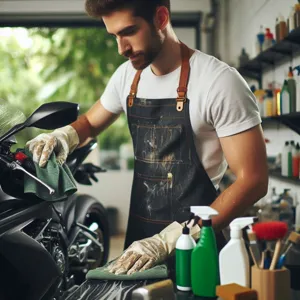
Before diving into the meticulous process of cleaning and detailing your motorbike, it’s crucial to prioritize safety. Preparing your bike properly not only ensures your own safety but also protects your beloved machine from potential damage during the cleaning process.
Start by finding a well-ventilated area to work in, ideally outdoors or in a spacious garage. This will help avoid any buildup of harmful fumes from cleaning solutions and protect your bike from accidental slips. Next, ensure that your bike is on a stable surface; using a center stand or a paddock stand can provide extra stability. This prevents the bike from tipping over while you scrub, rinse, or wax it.
Turn off the fuel valve and disconnect the battery if you’re using water, especially if your bike has any electrical components that could be affected. Cover sensitive areas such as the air intake, exhaust pipes, and any exposed electronics with plastic bags or tape to shield them from water and cleaning agents. This precaution will help prevent moisture from seeping into places it shouldn’t be, which can lead to costly repairs.
Don’t forget to wear protective gear for yourself. Safety goggles will shield your eyes from splashes, while gloves can protect your hands from harsh chemicals present in some cleaning solutions.
By taking these simple steps to prepare your bike for cleaning, you not only ensure a safer environment for yourself but also create the optimal conditions to keep your motorbike looking as good as new. A little prep work goes a long way in maintaining both safety and the integrity of your ride!
4. Step-by-Step Guide to Washing Your Motorbike
Washing your motorbike may seem like a straightforward task, but to achieve that showroom shine and maintain your bike’s longevity, a systematic approach is essential. Here’s a step-by-step guide to help you wash your motorbike effectively:
**Step 1: Gather Your Supplies**
Before you dive in, collect all the necessary supplies. You’ll need a bucket, a gentle motorcycle-specific soap, microfiber cloths, a soft sponge, a wheel brush, and a hose with a spray nozzle. Don’t forget to grab some chain cleaner and lube if you plan on cleaning your chain as well.
**Step 2: Choose the Right Spot**
find a shaded area to wash your bike. Direct sunlight can cause soap to dry too quickly, leading to unsightly streaks. A cool, dry location is ideal for ensuring that you can take your time without worrying about the heat.
**Step 3: Rinse Off Loose Dirt**
Start by rinsing your bike thoroughly with water. This step helps to remove loose dirt, grime, and debris. Use a gentle spray to avoid forcing water into sensitive areas, such as electrical components.
**Step 4: Wash the Bodywork**
Mix your motorcycle soap with water in a bucket according to the instructions. Using a soft sponge, begin washing the bodywork of your bike, starting from the top and working your way down. This technique ensures that dirt flows downwards and doesn’t get trapped on the cleaner surfaces. Be meticulous around crevices and curves, where grime tends to accumulate.
**Step 5: Clean the Wheels**
Now it’s time to tackle the wheels. Use a wheel brush to scrub the rims and tires, as they often collect the most dirt and brake dust. Reach into the spokes and other nooks with the brush to ensure every inch is clean. Rinse thoroughly once done.
**Step 6: Rinse and Dry**
After washing, give your bike another good rinse, ensuring that all soap and dirt residues are washed away. Use a microfiber cloth to gently dry your bike, paying special attention to metal parts to prevent water spots.
**Step 7: Final Touches**
Once your bike is dry, take a moment to clean the chain if needed. Apply chain cleaner, scrub with a brush, and rinse off before applying fresh chain lube. This step is crucial for keeping your bike running smoothly.
By following this step-by-step guide, you’ll not only achieve a sparkling clean motorbike but also help preserve its finish and functionality. Regular washes and maintenance can significantly extend the life of your ride, ensuring you enjoy every moment on the road.
5. How to Clean and Shine Your Bike’s Chrome

Cleaning and shining your bike’s chrome is a crucial step in maintaining its sleek appearance and preventing corrosion. Chrome accents add a distinctive flair to your motorcycle, but they can quickly lose their luster if not properly cared for. Here’s a detailed guide to bringing that brilliant shine back to your bike’s chrome components.
**Step 1: Gather Your Supplies**
Before diving into the cleaning process, gather the necessary supplies. You’ll need a high-quality chrome polish, a soft microfiber cloth, a gentle cleaner specifically designed for chrome, and an old toothbrush or soft-bristle brush for those hard-to-reach areas. If your chrome has heavy tarnishing or rust, consider a chrome cleaner with a bit more abrasive power, but be cautious not to scratch the surface.
**Step 2: Prepare Your Bike**
Start by ensuring your bike is cool to the touch. Washing a hot bike can lead to water spots and may damage the finish. Use a gentle soap and water solution to rinse off any dirt or grime from your bike’s exterior. Pay special attention to the areas around the chrome, as dirt can get trapped and cause scratches during the polishing process.
**Step 3: Apply the Chrome Cleaner**
Dampen your microfiber cloth with water and apply a small amount of chrome cleaner to it. Carefully rub the cleaner onto the chrome surfaces using a circular motion. This will help lift dirt and grime while ensuring an even application. For intricate designs or hard-to-reach areas, use your soft-bristle brush to gently scrub away any stubborn buildup.
**Step 4: Polish to Perfection**
Once the chrome is clean, it’s time to make it shine! Apply a small amount of chrome polish to a clean section of your microfiber cloth and buff the chrome in a circular motion. This step not only enhances the shine but also creates a protective layer that can help prevent future tarnishing. Continue buffing until you achieve a mirror-like finish.
**Step 5: Final Touches**
After polishing, take a moment to inspect all chrome areas for any missed spots or areas that may need extra attention. If you spot any remaining dullness, repeat the cleaning and polishing process as necessary. To maintain that brilliant shine, consider applying a coat of wax designed for chrome surfaces every few months.
Incorporating these steps into your bike maintenance routine will not only keep your chrome looking fabulous but also extend its lifespan against the elements. A well-maintained chrome finish enhances your motorcycle’s overall aesthetic, ensuring that it stands out on the road. So gear up, roll up your sleeves, and get ready to rev up your ride with that dazzling shine!
6. Detailing the Engine: Tips for a Pristine Finish
When it comes to cleaning and detailing your motorbike, the engine is often the centerpiece that deserves special attention. A gleaming engine not only enhances the overall aesthetic of your ride but also reflects the care and pride you take in your machine. Here are some pro tips for achieving that pristine finish.
**1. Gather Your Supplies:** Before diving into the task, ensure you have all the necessary cleaning supplies at hand. You’ll need a degreaser specifically formulated for engines, soft brushes with varying bristle stiffness, microfiber cloths, and a hose or pressure washer with a gentle spray setting. Don’t forget a bucket of warm, soapy water to tackle any grime.
**2. Let the Engine Cool:** Safety first! Always allow your engine to cool down before you start cleaning. Hot surfaces can cause burns, and applying cleaning products to a hot engine can lead to damage.
**3. Apply Degreaser:** Generously spray the degreaser onto the engine components, making sure to cover all areas, including the nooks and crannies where dirt tends to accumulate. Let the degreaser sit for a few minutes to break down the grease and grime.
**4. Scrub with Care:** Using soft-bristled brushes, gently scrub the engine surfaces. For tougher spots, you can use a stiffer brush, but be cautious around sensitive areas like rubber seals and electronic components to avoid damage. Work in small sections to ensure you don’t miss any spots.
**5. Rinse Thoroughly:** After scrubbing, rinse the engine with a gentle spray from your hose or pressure washer. Avoid blasting high-pressure water directly into electrical connections or sensitive areas to prevent water intrusion.
**6. Dry and Polish:** Once rinsed, use a microfiber cloth to pat dry the engine, removing any excess water. For an added touch of shine, consider applying a specialized engine polish. This step not only enhances the appearance but also helps provide a protective layer against future dirt accumulation.
**7. Regular Maintenance:** To keep your engine looking sharp, incorporate engine detailing into your regular maintenance routine. A quick wipe-down after every few rides can help prevent the buildup of grime and keep your motorbike looking its best.
By following these tips, you’ll not only achieve a pristine finish but also ensure that your motorbike’s engine remains in peak condition. A clean engine runs cooler and can even help you spot potential issues earlier, making your ride safer and more enjoyable. So roll up your sleeves and give your bike the care it deserves!
7. Maintaining Your Bike’s Paint: Waxing and Polishing Techniques
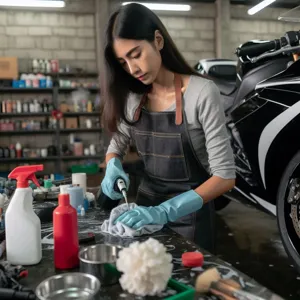
When it comes to maintaining your bike’s paint, the right waxing and polishing techniques can make all the difference in preserving its beauty and shine. A well-maintained finish not only enhances the overall aesthetic of your ride but also provides a protective layer against the elements, ensuring that your investment remains in top condition for years to come.
Start with a thorough wash to remove dirt, grime, and road debris. Use a gentle motorcycle-specific soap and a soft sponge to prevent scratching the surface. Rinse thoroughly and dry your bike with a microfiber towel to avoid water spots. Once your bike is clean and dry, inspect the paint for any imperfections such as swirl marks, scratches, or oxidation.
For polishing, choose a high-quality polish that’s appropriate for your bike’s finish—whether it’s matte, glossy, or metallic. Apply the polish using a soft applicator pad, working in small sections at a time. This will help eliminate any minor scratches and restore the paint’s luster. Remember to buff each section with a clean microfiber cloth, using circular motions to achieve an even shine.
Now, onto waxing! Waxing is your bike’s armor against harmful UV rays, dirt, and water. Opt for a good carnauba wax or a synthetic polymer wax that suits your bike’s paint type. Apply a thin layer using a foam applicator, allowing it to hazel before buffing it off with a fresh microfiber cloth. This not only adds depth to the color but also creates a hydrophobic layer, making it easier to clean in the future.
For extra protection, consider using a spray sealant after waxing. This will enhance the longevity of your wax and provide an additional layer of defense against the elements.
With these waxing and polishing techniques, you can keep your motorbike’s paint looking pristine, ensuring it turns heads every time you hit the road. Regular maintenance not only enhances the aesthetic appeal of your ride but also contributes to its overall value, making your investment truly shine.
8. Cleaning the Wheels and Tires: Best Practices
Cleaning the wheels and tires of your motorbike is not just a cosmetic upgrade; it’s a crucial aspect of maintenance that can enhance performance and safety. Neglecting these components can lead to accumulated grime, brake dust, and road debris that not only detracts from the bike’s aesthetic appeal but can also affect handling.
**Start with a Rinse:** Begin by rinsing the wheels and tires with water to remove loose dirt and mud. Use a gentle spray to avoid damaging any sensitive components nearby. This preliminary rinse helps to soften any stubborn grime, making the subsequent cleaning process easier.
**Choose the Right Cleaners:** Opt for a dedicated wheel cleaner that’s appropriate for your type of wheels—whether they’re aluminum, chrome, or painted. Avoid harsh chemicals that can strip protective coatings or damage the finish. For tires, a specialized tire cleaner will work wonders in breaking down the tough rubber grime that tends to accumulate over time.
**Scrubbing the Wheels:** Using a soft-bristle brush or a microfiber cloth, apply your chosen wheel cleaner and scrub in a circular motion. Pay special attention to the crevices and spokes where brake dust tends to gather. For intricate designs, a detailing brush can help reach those hard-to-access areas. Always follow the cleaner’s instructions for the best results, and rinse thoroughly afterward.
**Tackling the Tires:** When it comes to the tires, use a stiff brush to work in the tire cleaner. This will help lift dirt and debris from the rubber, restoring its original color and texture. Don’t forget to inspect the tires for any signs of damage or wear while you clean, as this can be a perfect opportunity to catch potential issues early.
**Final Touches:** After cleaning, it’s time to dry your wheels and tires properly. Use a microfiber towel to wipe down surfaces, ensuring no water spots are left behind. For an extra touch, you might consider applying a tire dressing to enhance the appearance of your tires and provide some protection against UV rays and cracking.
By following these best practices for cleaning your wheels and tires, you not only enhance the visual appeal of your motorbike but also contribute to its longevity and performance. A well-maintained ride is a joy to behold and a pleasure to ride, making your motorcycle experience all the more enjoyable!
9. The Importance of Cleaning the Chain and Sprockets
When it comes to maintaining your motorbike, one of the most crucial yet often overlooked tasks is cleaning the chain and sprockets. The chain is the vital connection between the engine and the rear wheel, transferring power and ensuring smooth acceleration. Over time, dirt, grime, and old lubricant can accumulate, leading to not only decreased performance but also potential damage to these critical components.
Regular cleaning of the chain and sprockets helps to prevent unnecessary wear and tear, extending their lifespan and enhancing your bike’s overall efficiency. A clean chain operates more smoothly, which translates to better power delivery and reduced strain on the engine. Additionally, a well-maintained chain reduces the risk of slipping, which can lead to catastrophic failures while riding.
To clean the chain and sprockets effectively, start by lifting the rear wheel off the ground using a paddock stand. This will make it much easier to rotate the wheel and access the entire chain. Use a quality chain cleaner and a stiff brush to remove built-up dirt and grime, paying special attention to the areas between the links. After scrubbing, rinse off the cleaner with water and allow the chain to dry thoroughly.
Once clean, apply a high-quality chain lubricant, ensuring it penetrates the rollers and side plates. Be sure to wipe away any excess, as excess lubricant can attract more dirt and debris. Don’t forget to inspect the sprockets for signs of wear; if you notice any hooked or damaged teeth, it may be time for a replacement.
By prioritizing the cleanliness of your chain and sprockets, you not only improve your motorbike’s performance but also enhance safety and reliability on the road. A little time spent on this essential maintenance task will pay off in smoother rides and a longer-lasting bike, ensuring you can rev up your ride with confidence.
10. Protecting Your Bike: Applying Sealants and Protectants
Once you’ve meticulously cleaned and detailed your motorbike, the next crucial step is to protect your hard work with sealants and protectants. This step not only enhances the aesthetic appeal of your ride but also serves as a shield against the elements, ensuring your bike remains in pristine condition for miles to come.
Start by choosing a high-quality paint sealant or wax specifically designed for motorcycles. These products create a durable barrier on the surface of your bike, guarding against UV rays, dirt, and moisture. When applying, make sure to work in small sections, using a foam applicator pad to spread the sealant evenly. The key is to apply thin layers, allowing each coat to cure properly before moving on to the next. This not only maximizes the protection but also offers a deep, reflective shine that makes your bike stand out on the road.
Don’t forget about the metal parts and chrome finishes! A dedicated metal protectant can help prevent rust and corrosion while giving those components a brilliant shine. Similar to the paint sealant, apply it with a clean microfiber cloth, buffing it gently to ensure even coverage and to reveal a lustrous finish.
For the tires, using a specialized tire dressing not only enhances their appearance but also protects against cracking and fading. Apply the dressing in an even manner, avoiding over-saturation, which can lead to slippage when riding.
Finally, consider using a protective spray for your bike’s leather components, if applicable. This will help maintain the leather’s suppleness and prevent it from drying out and cracking due to exposure to the sun and other environmental factors.
Taking the time to apply these sealants and protectants will not only keep your motorbike looking sharp but also extend its lifespan, allowing you to enjoy your ride for years to come. With a well-protected bike, every ride will feel like a brand-new experience.
11. Interior Detailing: Cleaning the Seat and Dashboard
When it comes to giving your motorbike the royal treatment, interior detailing is a crucial step that often gets overlooked. While the exterior gleams might catch the eye of passersby, a clean seat and dashboard can significantly enhance your riding experience and maintain the bike’s overall appeal.
**Cleaning the Seat**
Start by assessing your seat material—whether it’s leather, vinyl, or fabric—as this will dictate your cleaning approach. For leather seats, use a soft brush or cloth to remove loose dirt and debris before applying a specialized leather cleaner. Gently massage the cleaner into the surface, focusing on any stains or scuffs. Follow up with a conditioner to keep the leather supple and prevent cracking. If your seat is fabric, a vacuum will do wonders to eliminate dust and particles. For stubborn spots, a mild upholstery cleaner and a soft brush can help lift stains without damaging the fabric.
**Polishing the Dashboard**
Next, turn your attention to the dashboard. This area can accumulate grime and fingerprints, obscuring the visibility of your gauges and controls. Start by using a microfiber cloth to wipe away any dust. For deeper cleaning, a gentle all-purpose cleaner diluted with water works well—just ensure it’s safe for the specific materials used in your bike’s dashboard. Avoid harsh chemicals that could damage electronic components or the finish. Once cleaned, a dash polish can add a subtle shine and create a protective layer against future dust and grime.
Finally, don’t forget to inspect all the controls and switches while you’re at it. A little time spent on these often-neglected areas not only keeps your bike looking sharp but also ensures that everything operates smoothly when you’re ready to hit the road. By giving your motorbike’s interior the attention it deserves, you’re not just enhancing its aesthetic appeal, but also elevating your overall riding experience.
12. Seasonal Maintenance: Preparing Your Bike for Storage
As the riding season winds down and the chill of winter begins to set in, it’s crucial to prepare your beloved motorbike for hibernation. Seasonal maintenance is not just a task; it’s a ritual that ensures your bike remains in peak condition during its downtime. Properly preparing your motorcycle for storage can prevent damage and costly repairs when you’re ready to ride again.
Start by giving your bike a thorough wash. Remove any dirt, grime, and road salt that may have accumulated over the riding season. A clean bike not only looks better but also helps prevent corrosion. After washing, dry it completely and apply a coat of wax to protect the paint and chrome from moisture. This extra layer acts as a barrier against the elements and keeps your bike looking sleek.
Next, change the oil and filter. Old oil can contain contaminants that may lead to engine wear during the long months of inactivity. By replacing it with fresh oil, you’ll safeguard the engine and ensure smooth operation when you bring your bike back out of storage.
Don’t forget to check and inflate your tires. proper tire pressure is essential; under-inflated tires can develop flat spots and lead to structural damage. If possible, consider placing your bike on a stand to relieve the weight from the tires during storage.
Once you’ve tended to the exterior and engine, thinking about the fuel system is equally important. Add a fuel stabilizer to your gas tank and run the engine for a few minutes to circulate the treated fuel throughout the system. This prevents the fuel from breaking down and causing gunk to build up in the carburetor or fuel injectors.
Lastly, secure your motorcycle in a dry, temperature-controlled environment. A garage is ideal, but if one isn’t available, consider using a high-quality bike cover to protect it from dust and moisture. You might also want to invest in a battery maintainer to keep the battery charged and ready for action when the spring thaw arrives.
By following these seasonal maintenance steps, you’ll ensure that your motorbike emerges from storage ready to hit the road with confidence, allowing you to enjoy many more exhilarating rides in the future.
13. Common Mistakes to Avoid While Cleaning Your Motorbike
Cleaning and detailing your motorbike can be a rewarding experience, but it’s all too easy to fall into common traps that can lead to damage or ineffective cleaning. To ensure your bike retains its shine and performance, here are some pitfalls to avoid during your cleaning routine.
**1. Using the Wrong Cleaning Products:** One of the most common mistakes is reaching for household cleaners or abrasive materials that can scratch your bike’s surface or damage its finishes. Always opt for products specifically designed for motorcycles, as they take into account the unique materials and finishes used in bike construction.
**2. Ignoring the Owner’s Manual:** Your motorbike’s manual often includes specific cleaning instructions and recommendations. Skipping this crucial step can lead to using inappropriate methods or products that could harm your bike. Always take a moment to review the guidelines provided by the manufacturer before diving into your cleaning session.
**3. Neglecting the Chain:** While washing your bike, it’s easy to overlook the chain, which is a critical component for smooth operation. Failing to clean and lubricate the chain can lead to premature wear and tear. Make it a habit to regularly check and maintain the chain as part of your cleaning routine.
**4. Skipping the Detail Work:** Many riders tend to focus on the large surfaces and miss out on detailing the smaller, often neglected areas like the nooks and crannies, under the seat, and around the engine. These spots can accumulate grime and dirt over time, so be sure to give them the attention they deserve to keep your bike looking immaculate.
**5. Using Excess Water:** While thorough rinsing is essential, using too much water or high-pressure hoses can force water into sensitive areas, such as electrical components and bearings. Instead, use a gentle stream and avoid saturating the bike to prevent moisture buildup that can lead to corrosion.
**6. Rushing the Drying Process:** After washing, many riders hastily wipe down their bikes with a towel and call it a day. This can leave behind water spots or even streaks. Take your time to dry your motorbike properly, using a microfiber cloth that absorbs moisture without scratching the surface.
By steering clear of these common mistakes, you can ensure that your motorbike not only looks its best but also performs at its peak. Regular maintenance and proper cleaning techniques will keep your ride in top condition, allowing you to enjoy every mile on the road.
14. Eco-Friendly Cleaning Alternatives for Motorbikes
When it comes to cleaning your motorbike, eco-friendly alternatives are not just a trend—they’re a responsible choice that benefits both your bike and the environment. Traditional cleaning products can contain harsh chemicals that not only pose a threat to local ecosystems but can also degrade your bike’s finish over time. Thankfully, there are numerous natural solutions that are effective, safe, and sustainable.
First up is the classic vinegar solution. A simple mix of equal parts water and white vinegar can do wonders for removing grime and grease without the need for synthetic chemicals. Not only is vinegar a powerhouse when it comes to cutting through buildup, but it’s also biodegradable and safe for your bike’s surfaces.
Next, consider using baking soda as a gentle abrasive. This versatile powder can be mixed with water to create a paste perfect for tackling tough spots on your exhaust or wheels. Simply apply the paste, let it sit for a few minutes, and then scrub gently with a soft cloth or sponge. The result? A sparkling clean surface without the environmental guilt.
For those stubborn bugs and road grime, try a solution of biodegradable dish soap mixed with warm water. This mixture is effective at lifting dirt and debris while being gentle enough for use on various bike materials, from metal to fiberglass. Just be sure to rinse thoroughly to avoid soap residue.
Additionally, look for eco-friendly motorcycle cleaning products available on the market. Many brands are now offering biodegradable degreasers and waxes that are formulated specifically for motorbikes. These products are designed to be tough on dirt yet gentle on the planet, ensuring that your cleaning routine doesn’t come at the expense of environmental health.
Finally, don’t forget about the power of a good microfiber cloth. Not only are they great for polishing and capturing dust, but they are also reusable and durable, reducing the need for disposable paper towels.
By opting for these eco-friendly cleaning alternatives, you not only keep your motorbike looking pristine but also contribute to a healthier planet. So, gear up for your next cleaning session with these sustainable practices in mind, and ride with pride knowing you’re making a positive impact while enjoying your passion for motorbikes.
15. Conclusion: Keeping Your Bike Looking Great All Year Round
In conclusion, maintaining the pristine appearance of your motorbike requires consistent effort and a few pro tips, but the rewards are well worth it. A clean bike not only enhances its aesthetic appeal but also contributes to its longevity and performance. By establishing a regular cleaning routine—whether that’s weekly washes, monthly detailed cleanings, or seasonal wax applications—you can protect your investment from the elements and road grime that can cause wear and tear over time.
Remember, the key to keeping your bike looking great all year round lies in the right products and techniques. Choose high-quality cleaning solutions that are designed specifically for motorbikes, and don’t skimp on the tools—soft cloths and brushes are essential for avoiding scratches and damage.
Additionally, don’t forget the importance of detailing those hard-to-reach areas; a thorough cleaning of the engine, undercarriage, and spokes can make a world of difference. Regular inspections during cleaning sessions also allow you to catch any potential issues early on, saving you time and money in the long run.
Finally, consider the weather conditions in your area. If you live in a region prone to rain or road salt in the winter, be proactive by applying a protective sealant to shield your bike from corrosion and dirt buildup. With dedication and the right approach, you can ensure that your motorbike remains a head-turner on the road, reflecting the pride you take in your ride. Embrace these cleaning and detailing tips, and enjoy the satisfaction of riding a bike that not only performs well but looks fantastic too!
In conclusion, keeping your motorbike clean and well-detailed is not just about aesthetics; it’s a crucial part of maintenance that enhances performance and prolongs the life of your ride. By following the pro tips outlined in this post, you can ensure your bike shines like new and runs smoothly on every adventure. Remember, the attention you give to your motorbike reflects your passion for riding and your commitment to its care. So gear up, gather your cleaning supplies, and embark on this rewarding journey of motorcycle upkeep. Here’s to revving up your ride and enjoying every mile on the open road! Happy riding!


